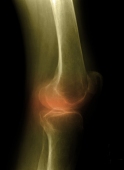
FRIDAY, April 12 (HealthDay News) — Special “mobility shoes” might ease the strain on the knees of people with knee arthritis, a small study has found.
This type of flat, flexible footwear is designed to mimic the biomechanics of walking barefoot, researchers from Rush University Medical Center in Chicago explained.
The study was funded by the Arthritis Foundation and included 16 people with knee osteoarthritis who wore specially made mobility shoes six hours per day, six days a week. The patients were evaluated after six weeks, three months and six months.
According to the researchers, long-term use of mobility shoes helped the patients adapt their gait (how they walk), which led to a reduction in what’s known as “knee loading” — the force placed on knees during daily activities.
This reduction in knee loading continued even after the patients stopped wearing the mobility shoes, according to the study published in the April 10 online edition of the journal Arthritis & Rheumatism.
Arthritis experts were encouraged by the findings.
“The data show convincing improvements in the ‘knee adduction moment,’ which is a measure of how the knee moves to the side as the foot strikes the ground,” said Dr. Jose Rodriguez, chief of reconstruction arthroplasty at Lenox Hill Hospital in New York City. “By diminishing these forces, the potential is a reduction in the progression of arthritis in the knee.”
He added that “the impressive part of the study was the fact that the biomechanical changes in gait pattern were also present using normal shoe wear at the end of the study, indicating a training effect.”
Another expert noted that getting the foot and knee to a more “natural” state is often productive.
“Obviously the bare foot is the ultimate shock absorber and mobility footwear allows the foot to absorb the forces during ambulation in a much more natural fashion than other modes of footwear,” explained Dr. Richard Iorio, professor and chief of adult reconstruction surgery at NYU Langone Medical Center in New York City.
“There have been similar findings in the ‘new running’ movement, where distance runners are even going barefoot to avoid the injuries associated with shoes,” Iorio added. “Anything that mechanically improves foot and ankle mechanics to minimize load on the knee will help an arthritic knee patient.”
Study author Dr. Najia Shakoor agreed. “Our investigation provides evidence that footwear choice may be an important consideration in managing knee osteoarthritis,” she said in a journal news release.
“There is much interest in biomechanical interventions, such as orthotic inserts, knee braces and footwear that aim to improve pain and delay osteoarthritis progression by decreasing impact on joints,” Shakoor noted.
Rodriguez did have a couple caveats to offer, however.
Further study is needed to see if the benefits persist long-term after people switch back to normal footwear, and while the study “represents excellent science,” it “needs to be repeated at a lab not associated with the design of the shoe,” he said.
Osteoarthritis, a painful swelling and stiffness in joints (including the hands, feet, knees or hips), affects over 27 million Americans over the age of 25, according to the American College of Rheumatology. The U.S. Centers for Disease Control and Prevention estimates that about 16 percent of Americans aged 45 and older develop symptomatic knee osteoarthritis, which is often due to injury or “wear and tear” on the joint.
More information
The American Academy of Orthopaedic Surgeons has more about knee osteoarthritis.

